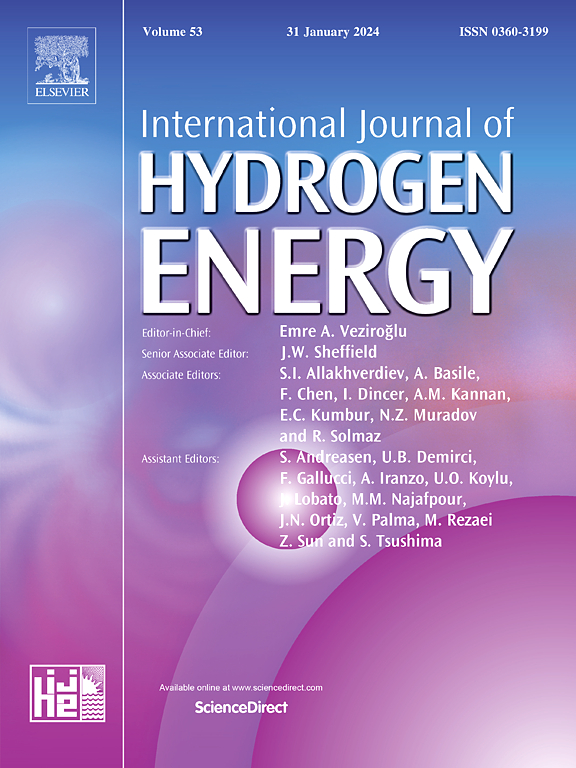Effect of distance of cylinder and release pressure on the hydrogen jet flame temperature distribution induced by impingement of ignited release of hydrogen
IF 8.1
2区 工程技术
Q1 CHEMISTRY, PHYSICAL
引用次数: 0
Abstract
Hydrogen is clean, green, and environmentally friendly, and it can be beneficial in solving the climate problem of global warming. However, hydrogen is flammable and explosive, and it is crucial to study the characteristics of hydrogen jet flame. At present, the temperature decay law of hydrogen jet flame after hitting the cylinder is not clear. In this paper, the temperature distribution of the jet flame formed on the surface of the cylinder after hydrogen leakage was experimentally investigated at a nozzle diameter of 1.50 mm, a leakage pressure of 0.15–0.30 MPa, and a nozzle distance of 0.20–0.40 m. The ground is approximately 0.16 m from the lower surface of the cylinder. The results of the study showed that the flame expansion region after hitting the cylinder and the maximum over-temperature increases with increasing initial pressure and decreasing cylinder-to-nozzle distance. In the longitudinal direction along the cylinder, relationship between dimensionless distance and dimensionless over-temperature satisfying Gaussian distribution. And when the longitudinal distance is greater than 0.10 m, the over-temperature increases with the distance from the cylinder to the nozzle. In the vertical direction, an exponential relationship is satisfied between dimensionless distance and dimensionless over-temperature. These temperature prediction models are only applicable to the boundary conditions in the paper. The results of the study contribute to the improvement of hydrogen safety.

气缸距离和释放压力对氢气点火释放冲击引起的氢气射流火焰温度分布的影响
氢是清洁、绿色、环保的,对解决全球变暖的气候问题是有益的。然而,氢气是易燃易爆的,对氢气喷射火焰特性的研究至关重要。目前,氢射流火焰撞击气缸后的温度衰减规律尚不清楚。本文在喷嘴直径为1.50 mm、泄漏压力为0.15 ~ 0.30 MPa、喷嘴距离为0.20 ~ 0.40 m时,实验研究了氢气泄漏后气缸表面形成的射流火焰的温度分布。地面距离圆筒下表面约0.16米。研究结果表明:随着初始压力的增大和缸口距离的减小,撞击缸后火焰扩展面积和最大过温增大;在圆柱体纵向上,无因次距离与无因次过温之间的关系满足高斯分布。当纵向距离大于0.10 m时,超温随气缸到喷嘴距离的增加而增加。在垂直方向上,无因次距离与无因次过温之间满足指数关系。这些温度预测模型只适用于本文的边界条件。研究结果有助于提高氢的安全性。
本文章由计算机程序翻译,如有差异,请以英文原文为准。
求助全文
约1分钟内获得全文
求助全文
来源期刊

International Journal of Hydrogen Energy
工程技术-环境科学
CiteScore
13.50
自引率
25.00%
发文量
3502
审稿时长
60 days
期刊介绍:
The objective of the International Journal of Hydrogen Energy is to facilitate the exchange of new ideas, technological advancements, and research findings in the field of Hydrogen Energy among scientists and engineers worldwide. This journal showcases original research, both analytical and experimental, covering various aspects of Hydrogen Energy. These include production, storage, transmission, utilization, enabling technologies, environmental impact, economic considerations, and global perspectives on hydrogen and its carriers such as NH3, CH4, alcohols, etc.
The utilization aspect encompasses various methods such as thermochemical (combustion), photochemical, electrochemical (fuel cells), and nuclear conversion of hydrogen, hydrogen isotopes, and hydrogen carriers into thermal, mechanical, and electrical energies. The applications of these energies can be found in transportation (including aerospace), industrial, commercial, and residential sectors.
 求助内容:
求助内容: 应助结果提醒方式:
应助结果提醒方式:


